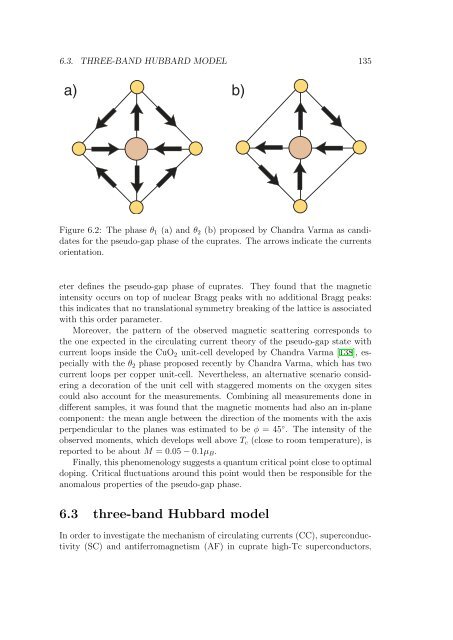pdf, 9 MiB - Infoscience - EPFL
pdf, 9 MiB - Infoscience - EPFL
pdf, 9 MiB - Infoscience - EPFL
You also want an ePaper? Increase the reach of your titles
YUMPU automatically turns print PDFs into web optimized ePapers that Google loves.
6.3. THREE-BAND HUBBARD MODEL 135<br />
a) b)<br />
Figure 6.2: The phase θ 1 (a) and θ 2 (b) proposed by Chandra Varma as candidates<br />
for the pseudo-gap phase of the cuprates. The arrows indicate the currents<br />
orientation.<br />
eter defines the pseudo-gap phase of cuprates. They found that the magnetic<br />
intensity occurs on top of nuclear Bragg peaks with no additional Bragg peaks:<br />
this indicates that no translational symmetry breaking of the lattice is associated<br />
with this order parameter.<br />
Moreover, the pattern of the observed magnetic scattering corresponds to<br />
the one expected in the circulating current theory of the pseudo-gap state with<br />
current loops inside the CuO 2 unit-cell developed by Chandra Varma [138], especially<br />
with the θ 2 phase proposed recently by Chandra Varma, which has two<br />
current loops per copper unit-cell. Nevertheless, an alternative scenario considering<br />
a decoration of the unit cell with staggered moments on the oxygen sites<br />
could also account for the measurements. Combining all measurements done in<br />
different samples, it was found that the magnetic moments had also an in-plane<br />
component: the mean angle between the direction of the moments with the axis<br />
perpendicular to the planes was estimated to be φ =45 ◦ . The intensity of the<br />
observed moments, which develops well above T c (close to room temperature), is<br />
reported to be about M =0.05 − 0.1µ B .<br />
Finally, this phenomenology suggests a quantum critical point close to optimal<br />
doping. Critical fluctuations around this point would then be responsible for the<br />
anomalous properties of the pseudo-gap phase.<br />
6.3 three-band Hubbard model<br />
In order to investigate the mechanism of circulating currents (CC), superconductivity<br />
(SC) and antiferromagnetism (AF) in cuprate high-Tc superconductors,
















